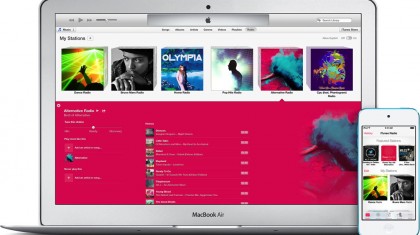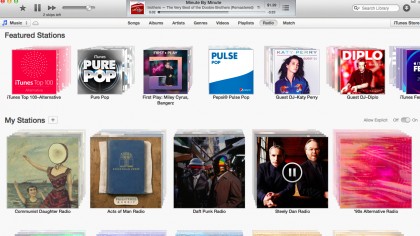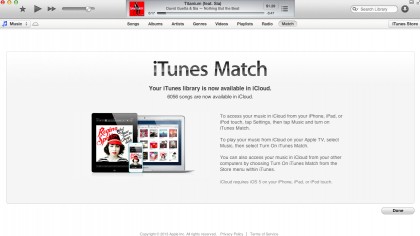TechRadar Verdict
Pros
- +
Well-integrated with iOS 7
- +
Few ads in the free version
- +
Massive selection of music
- +
Easy to precisely groom your stations
- +
Buy iTunes Match and lose the ads
Cons
- -
No option to "rent" whole albums
- -
It's beholden to iTunes, which is getting bloated
- -
Occasional disconnects on iPhone version
- -
Featured stations are a whiff
- -
US only, for now at least
Why you can trust TechRadar
Pity the poor maker of an iPhone flashlight app. There you are, minding your own business, selling a useful tool at ninety-nine cents a pop, and that punk Jony Ive goes and builds your product right into the control panel for his iOS 7. For one corner of the App Store, it's a true economic upheaval.
The same could be in store for Pandora, now that iTunes Radio is on the scene. The two are markedly similar services, letting users listen to endless musical streams based on their tastes, with the option to buy in for an ad-free experience.
The biggest difference is that Apple's internet radio is integrated into iOS and the Mac's OS X in a way that a third-party service would never be. It also boasts a library of 27 million tracks, a surprisingly sparse amount of ads in the free version (we'll see how long that lasts though) and the offer of iTunes Match if you pony up a mere $25 for a year of ad-free service.
Yes, Pandora has a reason to worry. iTunes Radio is an attractive deal, especially for those already entrenched in the Apple world. Services like Spotify and Rdio are likely safe, thanks to subscription services that let you download brand new albums in their entirety. And while iTunes Radio is yet another page in the increasingly overstuffed volume of iTunes, it's easily the most attractive streaming radio option on iOS, the MacBook and Apple TV.
Interface
iTunes Radio is available on iOS 7, where it runs out of the Music app, and Mac's OS X, where it works as an extension of iTunes. On either device the layout is the same: Featured Stations at the top, My Stations below that.
Those Featured Stations are an exclusive (read: not found on Pandora or other services) feature of iTunes Radio, but they're not much to brag about right now. There's a bit of Apple muscle on display, celebrity DJ playlists and a Beatles Radio station, which was a bit heavy on the Wings for our tastes.

Some of the stations are far less alluring. Streams like Pepsi Pulse Pop or the bafflingly named App Gamer Radio feel more like banner ads paying to sit at the top of your screen than something you'd actually tune into. "Gee, if Pepsi's musical taste is half as refreshing as its delicious cola beverage then…" thought no human ever.
Sign up for breaking news, reviews, opinion, top tech deals, and more.
Below the Featured Stations lies the real meat of iTunes Radio, My Stations. This is where the musical streams you create will be saved, and can be accessed or edited. Just like on Pandora and the rest of the competition, stations can be created by using a particular song, artist or genre as a jumping off point.
Music selection and stations
iTunes Radio has a phenomenal number of tracks, 27 million of them according to Apple, enough that it can break up a genre like Metal into Black Metal, Classic UK Metal, Doom Metal, Thrash Metal and five other types of metal. That's a lot of metal.
Stations can be sampled before being saved, and can also be arranged with a click and drag of the mouse. As with many Apple products the whole thing looks great. iTunes automatically pulls in album art for stations based on albums or single tracks, and artist portraits for ones based on a single band or artist.

For genre-based stations, iTunes uses a piece of high quality clip art. Color filters are used to differentiate musical subspecies. We can't be mixing out Alternative Rock with our Post-Punk Revival now can we? Some musical subsects, such as the delightfully named Yacht Rock branch of Classic Rock, get there own piece of album art, in this case an appropriately nautical one. All in all the experience is a visually pleasing one, and some of the more colorful stations seem designed to pop off the display of your iPhone 5c.
What's even better than the aesthetic is the way you can groom your stations just to your liking. Want a little more TV on the Radio in your Beck station, but had enough of those Beastie Boys? Simple enough, each station has two modifiers, "Play more like this" and "Never play this."

You can issue these commands with a star button next to the play button, where the back button would normally be (there's no going back on internet radio. This is the future folks.). You can also add a track to your iTunes Wish List to buy or simply research later.
The star button is nice for on the fly adjustments, but the deep dive comes when you click on a station in iTunes, or go to edit on your iPhone. From here you can manage your "Play more" and never again lists, adding or excluding any on iTunes.

There's also a slider that can be adjusted to three points: Hits, Variety and Discovery. Hits will get you mostly singles and songs with high popularity ratings in the iTunes Store, while Variety steps out of your genre comfort zone, and Discovery pulls in a lot of B-sides and remixes.
iTunes Radio also pays attention to your skips. You get six skips per hour, which are counted down by the play button. Jumping past a song generally sends iTunes reeling for your approval. Skip a song that's closely related to the musical seed of your station, and iTunes will reach for a deep cut. Do the same to an obscure track and iTunes will bust out a hit or a track from an artist it knows you like.

It's eager to please, almost too much so. It definitely errs on the side of familiarity and popular iTunes tracks until you whip it into shape. Your input does have an immediate effect though, and being able to manage it on your MacBook Air and then have the exact same stations on your iPhone 5s is one of the best parts of the experience.
However, that's not to say navigating your stations is flawless, one basic issue springs to mind. At this point iTunes on the Mac is pretty overstuffed. Even at launch iTunes Radio is big enough to be its own application, and having it as a tab within your Library can make for a sometimes jarring experience.

For example, if there's a song playing on Radio that you'd like to read up on, you can click it to see its iTunes Store write up. That's a good experience, the info is right at your fingertips. However, if you click back, like anyone raised on the web browser would do, you go back a page in the iTunes Store, rather than returning to your regularly scheduled radio station. That's a bad and disorienting experience.
iTunes is great, but it's getting bloated. Apple may want to consider separating iTunes and the iTunes Store, like it does on iOS, or at least get the gears turning more smoothly. On the iPhone, iTunes Radio works much more naturally as a tab in iTunes.

We appreciate that Apple folded Radio into iTunes, rather than put one more undeletable app on the home screen (Apple Maps, Stocks and Game Center don't need any more company in their junk folder). Still, the station management features are more powerful in conjunction with a mouse and keyboard, which makes us wish the Mac OS X experience could be smoothed out.
Also, iTunes Radio's dependance on iTunes might be a catch that keeps a lot of users on Pandora. Being able to just cruise over to Pandora's site on any old web browser is part what makes it such a simple service to use on a public computer or a friend's PC. iTunes allows for greater functionality, but it Radio feels a bit shackled to it.

As far as bugs go, we encountered only one during our testing period. On our iPhone 5, we got a "iTunes Radio currently unavailable" message about three times during a period of a week. This occurred when using WiFi or a cellular connection (iTunes Radio won't use your data connection unless you give it permission).
It definitely wasn't a connection issue though, because we were able to stream a track from our iCloud library using iTunes Match. In fact, doing so seemed to jump start the connection, and we were able to connect to a station once the stream had begun. This problem only occured on our iPhone, never on a MacBook.
All in all in, this issue strikes us the kind of snag you encounter during the launch of a product, and will likely be ironed out. We've reached out to Apple to see if this is a known issue, and will update if we receive a response.
Premium version and iTunes Match
iTunes Radio is free. You can stream an unlimited amount of music to your iTunes capable devices at no charge, with the only caveat being that you'll have to hear an ad ever five songs or so. That's pretty benign for the amount of content on offer here.
Still, there are some compelling reasons to pony up the $25 for the "premium," ad-free version of iTunes Radio. First, as we said, no ads. Second, it comes with iTunes Match.

iTunes Match takes any and all songs in your iTunes Library, across ten devices, and makes them available to you on any Apple device through the cloud. Even songs that weren't purchased from the iTunes Store, like tracks from ripped CDs or perhaps one obtained in a less than legal fashion, are given amnesty and Apple will give you credit for them in the cloud. Match will support up to 25,000 songs not purchased from iTunes.
Once these songs are clouded up, they can be downloaded or streamed to your registered iTunes devices. That means that you can use WiFi to stream your music and save hard drive space, or download tracks to your iPhone so you aren't sucking your data plan dry every time you want to hear Blue Monday.
We liked
iTunes Radio has a slick interface, a smart look and it's easy to customize quite precisely. It's great that you can tell it that you hate Kings of Leon before Use Somebody even shows up on your stream, you can populate a station with multiple artists you like, and easily manage those variables, in case your perceived love of Radiohead becomes overwhelming in the mix.
Two of the best things about iTunes have been melded with the internet Radio experience. First, the massive library of tracks that Apple has built up in the dozen years since iTunes launched (feeling old yet?) Second, it's using the same solid algorithms to analyze your preferences and feed you a steady diet of reliable hits and horizon expanding obscurities.
It works really well as part of the iOS 7 package. The radio can be controlled via Siri or the new control panel, and stations are searchable from the home screen. It's also tucked nicely into the iTunes on the iPhone, so weren't not stuck with another mandatory home screen icon. Seriously, does anyone use the Game Center?
iTunes Radio is shockingly low on adds. You'll likely hear two for every ten songs you stream. Perhaps that will change as the service grows more popular and demand increases, but for now, it feels like you're getting away with something.
And if you do pony up for the ad-free version, that's only $25 for a year. Compare that to around $37 for a year of Pandora. Plus, your money gets iTunes Match, which is excellent for anyone with a large MP3 collection and an iPhone.
We disliked
iTunes Radio is so big and so good that it feels buried as just another tab in your iTunes Library. It deserves its own section, among Music, TV Shows and Podcasts, or perhaps even it's application. It's less of a problem on iOS, where iTunes and the Music Store have already been separated, but it's rather confusing to jump between the iTunes Store and Radio.
Also, the fact that iTunes Radio is stuck in iTunes and can't run out of a browser will probably keep some Pandora fans from converting. We doubt Apple cares about this though, it'll likely benefit more by keeping people in its digital storefront, hoping for an impulse buy.
Our biggest disappointment is that iTunes Radio is so Pandora like, meaning you can't always listen to the exact song you want. Ask for Nirvana's Smells Like Teen Spirit, and you end up listening to Lithium. Now that's not bad for the price (free or $25 a year), but the option to pay more and get a Spotify or Rdio like service, where you can download whole albums, would have been nice.
Of course, that would probably hurt over all album sales, and it's obvious that Apple wants you to keep buying music. Giving you iTunes Match is nice incentive, but for those without much of a digital music collection, it's something of a non-starter. Even though Spotify costs a $120 a year, it's not hard to see why one might pay so much more for it.
The Featured Stations need some work. Some are good, some are downright terrible, but given the clout iTunes has, they could be truly great. Apple needs to get some eclectic personalities doing the DJ work, and commision some talk and comedy stations. Why not dip into that massive Podcast talent pool? Those guys are used to cranking out tons of great content for basically peanuts.
The random "iTunes Radio is unavailable" message was the only bug we encountered. While we haven't heard anything from Apple about it, it feels like your typical launch wrinkle that'll be ironed out soon.
Finally, how about a release date for the UK and other regions? It's got to be a matter of negotiating the international music licenses, which we're sure is a headache, but Apple as been utterly mum as far as expanding the service outside of the States.
Verdict
iTunes Radio is the best streaming radio option on iOS and a powerful competitor on the PC as well. It has a massive library, a fun interface and a good mind for figuring out what you'll like.
The fact that you can't sample entire albums will leave Spotify fans cold, but as a cheap way to access an obscene amount of music, it can't be beat. It's a solid experience whether you're on an Apple TV, Mac or a PC, but it's at it's very best on the iPhone and iPad. Look out Pandora, you might end up in an iOS junk drawer. We heard Apple Maps is looking for a roommate.
